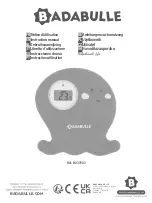
Installation instructions and Instructions for use
Subject to technical modifications
–
Date of Issue April/2022
9
Safety instructions
Winter operation:
Snow or ice can destroy the unit.
The unit may only be operated, if no ice or snow is lying on the cover.
During this time automatic control devices must be switched to
manual operation.
To prevent damage, please retract your sun protection device with rain,
snowfall or wind.
If automatic control devices are used, adjust the wind controller
analogously to the installed wind resistance class of your sun protection
device.
Wind resistance class 0
= wind force <4 (Beaufort),
a performance not required or not measured (according to DIN 13561) or
a product, that does not comply with the requirements of the wind
resistance class 1.
Wind resistance class 1
= wind force 4 (Beaufort),
moderate breeze, moderate wind, moves twigs and thin branches, whirls
up dust and loose paper
Velocity 20
–
27 km/h = 5.5
–
7.4 m/s
Wind resistance class 2
= wind force 5 (Beaufort),
fresh breeze, fresh wind. Smaller deciduous trees start to sway, white
crests are formed on lakes.
Velocity 28
–
37 km/h = 7.5
–
10.4 m/s
Installation instructions and Instructions for use
10
Subject to technical modifications
–
Date of Issue April/2022
Designated use
Sun protection
Thermal protection
Sight screen
Anti-glare blind
Rain protection (only partly!)
The inclination of the awning in the drawn-out position must be at least 14° to
prevent water pockets when it is raining.
Also with a sufficient inclination, a complete denseness of the seams cannot be
guaranteed when it is raining!
Installation instructions and Instructions for use
Subject to technical modifications
–
Date of Issue April/2022
11
Servicing, maintenance and repair
With the purchase of your awning you have opted for a high-quality product. To enjoy your awning for
as long as possible, please observe the following information:
Notes to awning covers made of brand acrylic fibres
Brand acrylic fibres, as used for awnings, are materials of the highest quality for awnings. As they are
dope-dyed, these materials show the highest light- and colour-fastness. In addition, their resistance to
tearing and resistance to weather, rotting and environmental effects is unsurpassed. Furthermore, a
special textile finishing makes them dirt-, water-, oil- and grease resistant. The awning cover is heavily
tested. At the weaving plant, at the awning manufacturer and during awning fabrication. As with other
covers, differences in the surface uniformity can also occur with the awning cover. When viewing from
the top or seeing through, you will perhaps find small knots, spots of colour, irregular runs of threads
or minimal differences and displacements in the design and rapport, as well as differences in the
colour. Please note, that the awning will cause a different colour effect in sunlight and in shade.
Naturally, the optical colour perception depends on the composition and the intensity of the emerging
light. With increasing depth of colour, more light will be absorbed and less will be reflected. Therefore
dark coloured covers let through a small amount of light, while light colours let a lot of light through.
Due to the part-absorption, the composition of the light shining through will be modified, which results
in other colour perceptions.
Due to the coloured pigments embedded in the cover and the impregnation, shadings caused
by crinkles or crumple folds can appear, that, especially with light colours, become visible as
strips of shade.
The function, strength or density of the cover will not be reduced by that. Minor differences in colours
between the different cover strips or differences in colours with regard to the collection of samples
cannot be ruled out. The fabrication of several strips also with varying widths depends on the overall
width of the awning.
Ripples in the cover and wrinkling at the seams can arise, because the cover is double rolled up at the
seams.
The highest strain is on the seams of the cover. When rolling up the cover, the seams and hems lie on
top of each other, intensifying the strain. Hems and seams will be pressed flat, increasing in length. As
a result, the lateral seams of the cover can hang down slightly.
Sagging as a result of the own weight of the cover is possible. These specified phenomenons are not
faults in the awning cover, which have been overseen in the testing; they are unavoidable due to
technical, material and physical regularities. They therefore do not entitle the customer to any refusal
or reduction of the purchase price.
Correspondingly, the guidelines for the assessment of ready-made awning covers, summarized by the
German Federal Association "Manufacture of technical textile registered association" (Bundesverband
Konfektion Technischer Textilien e. V.), are also an integral part of our conditions of sale and delivery.
Installation instructions and Instructions for use
12
Subject to technical modifications
–
Date of Issue April/2022
Servicing, maintenance and repair
Cleaning
Cleaning
As a sun protection device fixed outside, the unit can get dirty in the
course of time. This will not reduce the usability of your unit. The
powder-coated parts of your unit will remain presentable for longer, if
they are cleaned regularly with a soft woollen cloth.
Do not use
solvents, alcohol (rubbing alcohol) or scouring cleansing
agents!
Leaves or other foreign material lying on the awning cover and in the
awning cassette must be removed immediately. There is danger of
damage or crashing to the awning.
Preventive measures
If you have to draw in the cover in a wet condition, please draw it out for
drying when the next opportunity arises, to prevent marks caused by
mould or mildew.




































